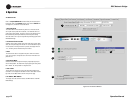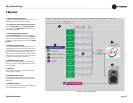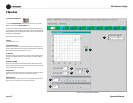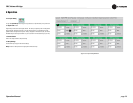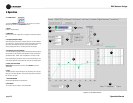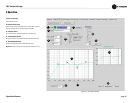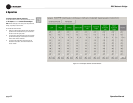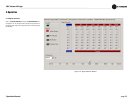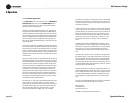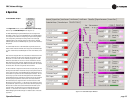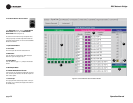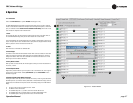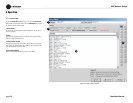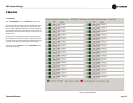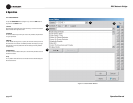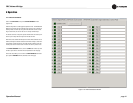
Operation Manual
DBC Network Bridge
page 34
4 Operation
4.7.7 CobraNet: Explanation
In the Signal Path window, Cinema Surround form, is a DBC Network
Channel Assign button which opens the CobraNet Output window
(described on the next page). If you need to understand how CobraNet
works, please read the following section.
CobraNet is a technology developed by Peak Audio, Inc. that allows real
time digital audio to be distributed over standard Fast (100Mb) Ethernet
hardware. CobraNet allows the DBC Network Bridge to not only have ana-
log or digital inputs, but also to provide 8 digital Inputs and 8 digital Out-
puts from a CobraNet network.These additional Inputs and Outputs allow
enhanced routing and processing capabilities, including the passing of
audio channels to other DBC Network Bridges to create larger mixing and
processing structures.
Transmission of digital audio via CobraNet is accomplished through 'Bun-
dles' and 'Slots'. Bundles are Ethernet packets that contain up to eight dig-
ital audio channels, called 'Slots'. Each digital audio channel is assigned a
position (1-8) within the Bundle, hence the name Slot. The Bundle is then
assigned a unique number that indicates how it will be transmitted on the
CobraNet network. A receiver merely needs to select the Bundle number to
receive the audio.
Bundles can be either multicast or unicast. Multicast bundles are sent to all
CobraNet network devices, while unicast bundles are sent to one, and only
one, CobraNet network device. Through the use of Fast Ethernet switches,
unicast transmission of bundles can greatly increase the number of bun-
dles that can be present on a CobraNet network since the bundles only go
to the device that is addressed. Since each device can send and receive
four bundles (i.e. up to 32 channels), great flexibility is allowed in the
routing of audio over the network. Assignment of bundles as multicast or
unicast is done through the assignment of the bundle number. Bundles
with numbers 1-255 are always multicast, while bundles 256-65,279 are
designated as unicast. Bundle assignments need to be unique, with only
one CobraNet transmitter allowed per bundle.
The coordination, i.e. clock master, of the CobraNet network is the function
of the 'Conductor'. The ‘Conductor Priority’ is set in each device and
decides which unit will be the Conductor. If the Conductor is removed from
the CobraNet network for any reason, the remaining devices decide who
becomes the Conductor based on a numerical hierarchy, i.e. priority
‘0’=never and ‘255’=always.The PS-8810 is set as ‘32’ as a default.
The Conductor is responsible for ensuring that all devices on the CobraNet
network transmit their bundles in a coordinated way. The Conductor recog-
nizes each device on the network and assigns a transmission position for
each bundle of each device.
In addition the Conductor sends master clock to each device to ensure that
all audio is synchronous. Like a conductor of an orchestra, the Conductor
signals the beginning of a synchronous transmission cycle, and then each
device sends its bundle(s) in lock step. This occurs 750 times a second,
with each audio channel having 64 samples of 48KHz audio. Each audio
channel can be sent as 16, 20, or 24 bit samples. if 24bit audio is used
then a bundle will be reduced to 7 channels. There is a fixed latency of
5.33ms.
CobraNet networks utilize Fast (100Mb) Ethernet hardware and can use
either repeater hubs or switches. A repeater hub is a device that takes the
data that comes into each port, and sends it back out on all ports except the
port it came in on. As a result, only multicast bundles can be used in
repeater hub networks and these need to be limited to 8 bundles per net-
work.
On the other hand, switches are much more efficient, in that they examine
the destination address of each packet of data received on each port, then
switch that data to the particular recipient of that packet. Unicast bundles
exploit this feature to minimize the audio traffic on the CobraNet network.
The result is that an almost limitless number of unicast bundles can be on
a switched CobraNet network. Multicast bundles are allowed on a switched
network, but they must be used with care.
Peak recommends that not more than four multicast bundles be used in a
switched CobraNet network. Peak also advise not to mix ordinary computer
data on a repeater hub network, as this could result in dropout in the audio.
In switched CobraNet networks, coexistence of CobraNet audio and ordi-
nary computer data is possible, because there are no collisions with the
audio.
If there are only two DBC Network Bridge units involved in a CobraNet net-
work these can be connected using CAT 5 crossover cables.
More information:
www.peakaudio.com
www.iqaudiosystems.com
CobraNet is a registered trademark of Peak Audio, Inc.



